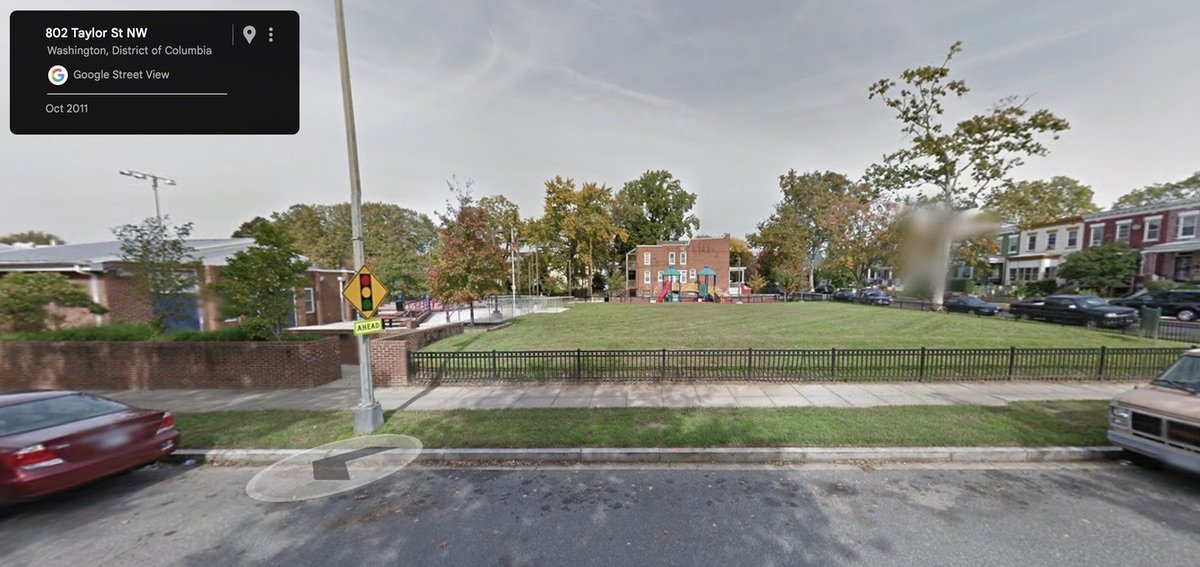A look at historical, systemic racism in Petworth real estate
/Sign signaling a racially restricted home development. (Credit: DC Public Library, Provided by Prologue DC)
by Austin Schott
I found out this week that my street was essentially the dividing line between white households and non-white households in Petworth before 1948. That’s a startling realization.
I was looking at a 1937 Federal Housing Administration (FHA) map, which had rated neighborhood values. The FHA had plotted these ratings largely off of race.
Reading the map, I realized that my street split the neighborhood clean in two. I looked out my window and realized that the houses I was looking at on the north side of the street had been reserved for white residents. According to Prologue DC’s Mapping Segregation in Washington DC project, my block was 93% non-white, the next block north was 38% non-white, and the block after that was only 2% non-white.
FHA’s 1937 Grading Map shows lower ratings for largely nonwhite neighborhoods (nonwhite residents are signified by dots) (credit: Prologue DC)
Historians Mara Cherkasky and Sarah Jane Shoenfeld, of Prologue DC, along with GIS specialists Brian Kraft and Kevin Ehrman-Solberg, have devoted efforts since 2014 to mapping these racially restricted covenants in DC to illuminate the racism ingrained into DC housing history.
Similarly, Tanya Golash-Boza is a sociologist who grew up in Petworth and now studies race and gentrification. Both Cherkasky and Golash-Boza have presented in TedX seminars examining housing segregation in DC and Petworth-area gentrification.
Prologue DC’s namesake stems from the Shakespeare quote, “What’s past is prologue,” meaning our history sets the stage for what comes next. Cherkasky and Golash-Boza feel that learning the history of segregation in one’s neighborhood is an important community service.
I recently met with Cherkasky, Shoenfeld and Golash-Boza to discuss the history of segregation in Petworth.
Historian Mara Cherkasky gives a Tedx talk on housing segregation in DC.
Sociologist Tanya Golash-Boza giving a Tedx talk about gentrification in Petworth, DC.
Racially Restricted Covenants
At the turn of the 20th century, developers would segregate neighborhoods with racially restricted covenants (language in property deeds excluding people of color from renting or purchasing the property). According to Cherkasky, developers first began using covenants following the 1896 Supreme Court case Plessy v. Ferguson which established the “separate but equal” doctrine of racial segregation, although the covenants were not widely used until the 1910s. Developers suggested that non-white residents, including Black, Asian, and sometimes Jewish residents, would decrease property values so they blocked off whole sections of housing for exclusively white residents.
A 1908 racially restricted covenant used in Columbia Heights, 1908 (Provided by Prologue DC)
In addition to developers, neighborhood groups would sometimes petition to block off their neighborhoods to non-white residents themselves. According to Prologue DC, “In 1946, neighbors on Randolph Street signed this agreement to bar Black residents for 50 years. Upon being filed with the DC Recorder of Deeds, it became legally enforceable. The Petworth Citizens Association brought lawsuits to uphold racial covenants and, in at least one case, purchased a property without a covenant to prevent its being sold to a black buyer.”
An example of a petitioned racially restricted covenant on Randolph Street, 1946
(Provided by Prologue DC)
Racially restricted covenants were ruled to be unenforceable in 1948, but that didn’t lead to integration. Prologue DC tells the following story about Petworth’s glacial pace-of-change:
When a Black physician, Clarence D. Hinton and his wife bought a house on Farragut Street in 1953 – where racially restricted covenants had previously forbade Black ownership – they, according to Prologue DC, “operated through a white ‘straw’ buyer who made the purchase on their behalf.”
Redlining
Developers further divided city residents by race via redlining and similar practices. The Federal Housing Administration did not to back bank loans for mortgages in majority-Black neighborhoods, often marked in red on the maps they used, preventing banks from lending to potential home buyers there. “Before 1968, 98% of the loans subsidized by the FHA [across America] went to white families,” notes Golash-Boza.
Meanwhile, the Federal Housing Administration and other government agencies incentivized white families to move to strictly white neighborhoods with subsidies, deed restrictions, and eventually low-interest mortgages through the 1944 GI Bill.
Prologue DC’s mapping project shows red and blue blocks to signify racially restricted housing covenants.
(Mapped by Prologue DC)
The Federal Housing Administration didn’t color code DC’s maps, but other maps ranked neighborhoods by value. Homes south of Park Rd NW were rated poorly, but homes to the worth were ranked relatively well. Prologue DC shared this map and color-coded it by grade.
Petworth resident Melvin Craig says in a recording on Prologue DC’s website that “Park Road northwest was kind of the dividing line. You had Blacks living to the South, but from Park Road north, it was all white.”
The 1954 Supreme Court Case Brown v Board of Education and The Fair Housing Act of 1968 eventually prohibited restricting education and housing respectively based on race. But instead of fostering diverse communities, white residents often departed communities altogether.
“In 1953, Rudolf Elementary, Roosevelt High, MacFarland Middle School [greater-Petworth schools at the time] were 100 percent white — they were segregated schools,” Golash-Boza said. “In 1954, when schools opened, those schools all allowed Black children to attend. Really quickly — within two, three, or four years — those schools became 100 percent Black. By the 1970s, Petworth was 90% Black, and I think there was a peak of about 96% Black by 1990.”
Disinvestment
White residents’ exodus from cities led to a lack of capital in urban centers, including Petworth. Lacking schools and services further encouraged wealthy, non-white residents to leave as well.
“Disinvestment occurred and persisted so that the schools weren’t very good,” Cherkasky said. “Money was invested outside the city, so people in the city didn't have good job opportunities or good educational opportunities.”
Although Petworth and Brightwood were previously middle-income Black neighborhoods, “Once middle-class Black people left, because the city wasn’t doing so well, things went further downhill.”
Golash-Boza further suggests that federal government policies at that time, primarily the 1980s, prioritized policing at the expense of schools and community programs, causing neighborhoods to fall to relative disrepair. Golash-Boza has extensively researched the intersection of race and incarceration, and says the incarceration rate in DC was the highest in the world at the time. In 1997, she suggests, 50 percent of Black men in DC, were either “in prison, on a warrant on probation, on parole, or otherwise under the criminal justice system.”
Petworth Today
Although explicitly racist housing policies are outlawed today, the effects continue to perpetuate in our communities. Shoenfeld reports that the low property values in Petworth made the community ripe for redevelopment, sometimes at the expense of long-time residents. “It's not benefiting them if people can't pay the property tax anymore,” Shoenfeld said.
She also feels recent public investment in Petworth as white residents move in demonstrates continued racist undertones. “It feels very unfair because there are people that were begging for these things — like pedestrian-friendly streets.” Now we have vast improvements to infrastructure, which she is very thankful for, but Shoenfeld notes, “It's so obvious who it’s for.”
Golash-Boza provides three recommendations on how residents can help address lingering effects of systematic racism in housing:
Get involved in public schools
Support public housing
Learn about the history of your neighborhood
Golash-Boza notes that examining how systemic racism devalued our community in the past will help us address its remnants in the future.
Editor’s Note 3/1: This article was updated with some minor changes, including incorrectly identifying the real estate agent responsible for handling the purchase of the Hintons’ Farragut Street home.



















